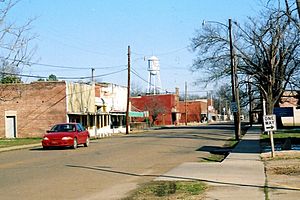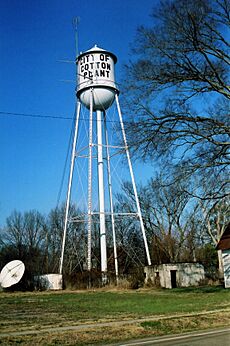Cotton Plant, Arkansas facts for kids
Quick facts for kids
Cotton Plant, Arkansas
|
|
|---|---|

Main Street, Cotton Plant, February 2007
|
|

Location of Cotton Plant in Woodruff County, Arkansas.
|
|
| Country | United States |
| State | Arkansas |
| County | Woodruff |
| Incorporated | November 14, 1887 |
| Government | |
| • Type | Mayor–council |
| Area | |
| • Total | 1.04 sq mi (2.69 km2) |
| • Land | 1.04 sq mi (2.69 km2) |
| • Water | 0.00 sq mi (0.00 km2) |
| Elevation | 190 ft (60 m) |
| Population
(2020)
|
|
| • Total | 529 |
| • Density | 509.14/sq mi (196.62/km2) |
| Time zone | UTC−06:00 (Central (CST)) |
| • Summer (DST) | UTC−05:00 (CDT) |
| ZIP Code |
72036
|
| Area code(s) | 870 |
| FIPS code | 05-15550 |
| GNIS feature ID | 2404137 |
Cotton Plant is a small city located in Woodruff County, Arkansas, in the United States. In 2020, about 529 people lived there.
Contents
History of Cotton Plant

When the first settlers arrived in the Cotton Plant area around 1820, it was covered with thick forests and tall cane plants. The small community that started there was first called Richmond.
In 1846, a man named William Lynch brought cotton seeds from Mississippi. The cotton plants grew very well in the area. Because there was already a town named Richmond in Arkansas, the community had to change its name. They chose "Cotton Plant" to celebrate their new successful crop.
During the American Civil War, a battle happened near Cotton Plant on July 7, 1862. Soldiers from the Confederate army and local people fought against the Union army. The Union army won this battle. This victory helped the Union forces move on to take other important cities in Arkansas, like Helena and Little Rock.
The town's economy grew when the Batesville and Brinkley Railroad was finished in 1881. This brought new jobs with warehouses, cotton gins (machines that separate cotton fibers), and cotton presses. Downtown Cotton Plant became a busy place. Later, in 1908, the Missouri and North Arkansas Railroad opened up the timber (wood) industry. This led to new factories for wood products, like sawmills and veneer plants.
Cotton Plant faced tough times during the Great Depression in the 1930s. To help, the Works Progress Administration (a government program) built a water and sewer system for the town in 1935. This project was a big deal, and people celebrated its completion. The town was also affected by World War II, but it grew and became very successful in the 1950s after the war ended.
Geography of Cotton Plant
Cotton Plant covers an area of about 1.0 square mile (2.6 square kilometers). All of this area is land.
Population of Cotton Plant
| Historical population | |||
|---|---|---|---|
| Census | Pop. | %± | |
| 1880 | 98 | — | |
| 1890 | 429 | 337.8% | |
| 1900 | 458 | 6.8% | |
| 1910 | 1,081 | 136.0% | |
| 1920 | 1,661 | 53.7% | |
| 1930 | 1,689 | 1.7% | |
| 1940 | 1,778 | 5.3% | |
| 1950 | 1,838 | 3.4% | |
| 1960 | 1,704 | −7.3% | |
| 1970 | 1,657 | −2.8% | |
| 1980 | 1,323 | −20.2% | |
| 1990 | 1,150 | −13.1% | |
| 2000 | 960 | −16.5% | |
| 2010 | 649 | −32.4% | |
| 2020 | 529 | −18.5% | |
| U.S. Decennial Census | |||
The United States Census Bureau counts the number of people living in cities every ten years. In 2020, the census showed that 529 people lived in Cotton Plant. There were 282 households and 153 families in the city at that time.
What the 2020 Census Shows
The table below shows the different groups of people living in Cotton Plant according to the 2020 census.
| Race | Number of People | Percentage |
|---|---|---|
| White | 133 | 25.14% |
| Black or African American | 363 | 68.62% |
| Asian | 1 | 0.19% |
| Other/Mixed | 25 | 4.73% |
| Hispanic or Latino | 7 | 1.32% |
Education in Cotton Plant
Students in Cotton Plant attend public schools run by the Augusta School District. These schools provide education from early childhood up through high school. Students usually graduate from Augusta High School.
Before 2004, Cotton Plant had its own school district. But on July 1, 2004, the Cotton Plant School District joined with the Augusta School District. Cotton Plant Elementary School stayed open for a while, teaching students from pre-kindergarten to third grade. However, in 2014, the Augusta School District decided to close Cotton Plant Elementary, and the Arkansas Department of Education approved this decision.
Historic Places in Cotton Plant
There are two important places in Cotton Plant that are listed on the National Register of Historic Places. This means they are recognized for their historical importance. These sites are the Cotton Plant Commercial Historic District and the Cotton Plant Water Tower.
Famous People from Cotton Plant
Many notable people have come from Cotton Plant, including:
- Johnnie S. Aikens, a state representative from Missouri.
- Jim McElroy, a professional basketball player.
- Pearl Peden Oldfield, the first woman from Arkansas to be elected to Congress.
- Florence Price, a famous classical composer, pianist, and music teacher.
- Sister Rosetta Tharpe, a gospel singer who started performing in local churches when she was only four years old.
- Peetie Wheatstraw, a blues singer who made many recordings.
See also
 In Spanish: Cotton Plant para niños
In Spanish: Cotton Plant para niños

